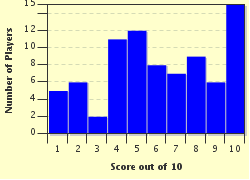Quiz Answer Key and Fun Facts
1. If an isotope of boron has a mass number of eleven, how many neutrons does it have?
2. Which scientist discovered the electron?
3. What would happen if a chemist mixed pure sodium with water?
4. If a strip of red litmus paper is placed into a solution and the paper turns blue, what is true about the solution?
5. Which of the following elements is the most electronegative?
6. Based on periodic trends, when you move left to right across a family on the periodic table ionization energy decreases.
7. Based on the ideal gas law, and a constant temperature, what happens to the volume of a gaseous system when the pressure decreases?
8. To determine the amount of valence electrons an element has, look at the last digit of the element's what?
9. Which of the following ions is generally considered insoluble?
10. A catalyst speeds up a chemical reaction by lowering the activation energy.
Source: Author
Computer100
This quiz was reviewed by FunTrivia editor
rossian before going online.
Any errors found in FunTrivia content are routinely corrected through our feedback system.


